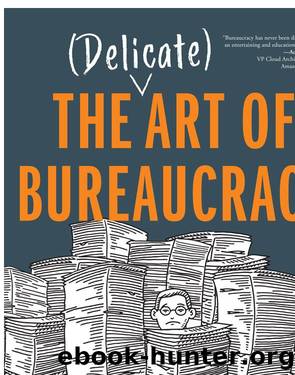The (Delicate) Art of Bureaucracy by Mark Schwartz;

Author:Mark Schwartz;
Language: eng
Format: epub
Publisher: IT Revolution Press (NBN)
(1) difficult to make a mistake to begin with; (2) easy to identify a problem or know when a mistake was made; (3) easy in the normal course of doing the work to notify a supervisor of the mistake or problem; and (4) consistent in what would happen next, which is that the supervisor would quickly determine what to do about it.12
Now that’s learning and enabling bureaucracy.
As process improvements were proposed and their effectiveness was confirmed, they were then standardized across employees and teams. This had a number of benefits. It gave workers a basis for their continuous improvement, since they always had a baseline process whose efficiency they could measure. It improved safety because each process was documented and could be examined carefully for risks. Inventory control became easier for just-in-time provisioning of resources. Job rotation became easier and fairer. And finally, the entire system became more agile, because workers could quickly reskill and immediately begin improving processes. They became, over time, experts in continuous improvement.
This all took place within a traditional management hierarchy, well supplied with layers of middle management. Managers, however, were taught to view themselves as problem-solvers whose responsibility was to help the floor workers realize their process improvements. They were valued for their expertise, and it was through this expertise that they become managers. It was Weberian “domination through knowledge.”13
Adler concluded that NUMMI was able to learn through a synergistic combination of its formal, standardized work process and various informal cultural aspects, including the facts that it cultivated broader skill sets among its employees and that it widely shared principles such as continuous improvement.14 Just as with Amazon’s fourteen leadership principles, shared values empowered employees to make decisions knowing that they would be consistent with management’s intentions.
Verdict: Learning Bureaucracy Is Agile Too
A learning bureaucracy is bureaucracy as a storehouse of institutional knowledge, knowledge that is added to and refined over time. It’s bureaucracy that keeps employees engaged and committed and uses their abilities to improve processes, not just their abilities to turn wrenches or fit car parts into place. It employs the more likable characteristics of Weberian bureaucracy: rules and standards that provide shared knowledge and comfort, and a hierarchy of roles that is truly meritocratic and uses the talents of its managers and workers.
Once again, the parallels with today’s IT practices are notable. Both the California Division of Highways and NUMMI based their continuous improvements on hypothesis-testing—just as digital practices, often derived from Eric Ries’s book The Lean Startup, treat system requirements as hypotheses and insist that they be tested. They both built cultures that encouraged employees to feel comfortable proposing innovations and process improvements, just as DevOps uses blameless retrospectives and supportive small-team interactions. These are not just surface similarities, but deep cultural affinities.
Download
This site does not store any files on its server. We only index and link to content provided by other sites. Please contact the content providers to delete copyright contents if any and email us, we'll remove relevant links or contents immediately.
Bullshit Jobs by David Graeber(3958)
Radical Candor by Kim Scott(2595)
I Am Right, You Are Wrong by Edward De Bono(2348)
23:27 by H. L. Roberts(2155)
Nomadland by Jessica Bruder(1976)
Average Is Over by Tyler Cowen(1763)
The Conflict Resolution Phrase Book by Barbara Mitchell & Cornelia Gamlem(1685)
Out of Our Minds: Learning to Be Creative by Ken Robinson(1635)
High-Impact Interview Questions by Victoria A. Hoevemeyer(1620)
The Ideal Team Player by Patrick M. Lencioni(1573)
An Everyone Culture: Becoming a Deliberately Developmental Organization by Robert Kegan & Lisa Laskow Lahey(1536)
The Asshole Survival Guide by Robert I. Sutton(1515)
Automatic Society by Bernard Stiegler(1475)
Who by Street Randy & Smart Geoff(1431)
Unleashed by Anne Morriss & Frances Frei(1430)
Who Moved My Cheese?: An Amazing Way to Deal With Change in Your Work and in Your Life by Johnson Spencer(1423)
42 Rules of Employee Engagement by Susan Stamm(1406)
96 Great Interview Questions to Ask Before You Hire by Paul Falcone(1363)
The Power of Disability by Al Etmanski(1298)
